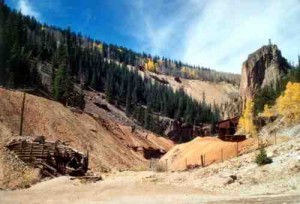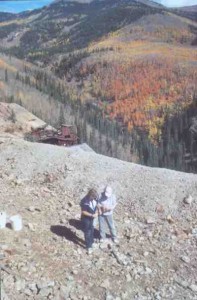Essay by John Mattingly
Agriculture – July 2006 – Colorado Central Magazine
I’VE BEEN TRYING To quit farming for almost 40 years. This year I succeeded. The problem with quitting has never been desire. All 40 years I’ve nursed a lurking urge to get on with my life and get into a decent profession — something with regular hours, good health care, and a pension. The problem has been timing.
In the summer, it’s impossible to quit. Irrigation water is running against hot winds, weeds are trying to move in. Your footprint on the ground feels essential when the responsibilities, and rewards, are growing. Literally. You started out managing the farm, but by the Ides of Summer, the farm is managing you. Quitting is impossible.
In fall, the days get shorter, the harvests begin. With them comes a contagious satisfaction that grows into a kind of survivor’s conceit. You made it. All the troubles and triumphs are over, behind you. The crop is in. So is the money. You start to get checks and hundred dollar bills. Your bank account actually shows a positive balance for impossibly long periods, sometimes as much as a week.
As the sun lowers on the horizon, giving the afternoons a rich, slanted light, the fields slowly turn from green to straw to brown, and as they do, you automatically do some preparation for next year. The crop rotation is in your head: The old alfalfa has to be plowed out, the barley straw has to be chopped and tilled with a dash of nitrogen for the soil bugs to feast on. The canola stubble needs to be stirred and ridged against the wind. All of these operations are done much as one foot steps ahead of the other when walking. Next season starts with the conclusion of the current one. Quitting in the fall is possible, but not probable, partly due to survivor’s conceit but mainly due to the seamless succession between seasons.
When winter settles in, the days get short, but the nights expand, leaving time for activities after dark. It’s a chance to catch up with friends, read, enjoy the holidays, attend the promotional dinners offered by seed and equipment dealers. During the day, there’ s shipping and movement of last year’s crop, and the money keeps coming, which starts the figuring process. Will there be enough left over to operate next spring? How much equipment needs to be traded or acquired? Do you need to schedule an appointment with the banker?
But these processes aren’t stressful. In fact, the immense relief you feel over the winter months could only be felt if you had gone through a significant, if trying, time during the previous summer. You know you could never appreciate such relaxation and peace if your vigor hadn’t been tested to the limit. The stress of summer enables an abiding simplicity and enjoyment of winter that feels well-earned.
SPRING COMES AT YOU like the seductive music of a snake charmer. It starts playing somewhere in the distance, then comes closer and closer, blending in with the smells of thawing earth and the diesel exhaust from your tractor. You can’t wait to turn brown fields to green again. Your batteries are fully charged from the long nights of winter. You have a little money in the bank, enough to order seed, fuel and fertilizer. There’ s something on the horizon that makes you either hopeful or curious: talk of a crop that might reach high prices, a new piece of machinery you bought or traded for, a different tillage practice you tried last fall that will either be successful or scrapped. These become strands of a rope that pull you in, leading you toward the irresistible gate of The Familiar. Not only is quitting impossible during this time, it doesn’t even register in the brain as an option.
So you farm for 40 years, then wake up like a double-downed Rip Van Winkle in a world that seems to have moved along without you. The farm became not only a profession, but a hobby, an avocation, a calling. It became the source of your livelihood and your education, your entertainment and your enlightenment. The farm became your world.
Placing this image into the Big Picture, I now see that I was no more than a vagrant. Like so many who have worked the earth of the West, I came, I farmed, I left. I endeavored to leave things better than I found them, but in truth, I was part of the extractive frenzy that characterizes the behavior of many who pass through this fragile, inspiring landscape. My father wasn’t a farmer and my son turned his head toward town soon after high school. Perhaps he actually listened to some of the things I said about quitting.
AFTER MY PARENTS LEARNED I was farming instead of going to college, there was an amused embarrassment in their voice when they spoke about me. Surely it was a phase, the passing fancy of a young man sowing his wild oats in actual topsoil. In point of fact, I was too busy trying to un-sow wild oats from my various fields to register their concern. There was some rebellious joy in doing something no one expected me to do, but it was the genuine nature of the work that hooked me.
I still have all of my crop and financial records back to the late Sixties when I got started. Diesel fuel was 11 cents a gallon, delivered to my farm’s bulk tank. Phosphorus fertilizer was $18 a ton, ammonium nitrogen sold for $8 a ton. A new pickup cost $4,500. A full line of haying equipment cost $18,000. A decent combine could be had for $16,000. Two men worked for me, each receiving $300 a month. They worked a strong 12-hour day. No social security withheld, no workman’s comp. Hay sold for $35 a ton, wheat hit $3 a bushel, I got $4.60/cwt for corn, and pintos were around $11/cwt.
In 2005, diesel was $2.60 a gallon, phosphorus $325/ton, nitrogen $280/ton, a new pickup $25,000, haying equipment about $200,000, a combine the same. A good hired man pulled $3,000 per month in take-home, and I spent another $1,200 a month for social security, unemployment, and workman’s comp. Hay sold for $100/ton, wheat hit $2.80 a bushel, corn $4.30/cwt, and pintos are around $14/cwt.
Yields increased in the last 40 years, but not in the same multiples as input costs. Not even close. In round numbers, input costs have increased about tenfold or more while market prices have remained the same, or increased only two or threefold. In terms of parity, farm commodity prices simply have not held their own. As a farmer, I suspect the difference was extracted from the topsoil, from that six or eight inches of productive earth that all life depends upon. In the end, sooner or later, this bill must be paid.
At a meeting of Colorado Wheat Growers in the late 1990s I heard our keynote speaker, the Secretary of Agriculture, brag on farmers for being so efficient that they had “held down the cost of food to the American consumer.”
I stood up during the question period and asked the Secretary to exclude me from the group of farmers he was bragging about. I was, in fact, a bit disturbed by the things I had seen and done over the years as an unwilling participant in the nation’s cheap food policies. I confessed that I’d seen farmers put contaminated product into the market stream, use restricted pesticides off-label, and even use banned chemicals, all because they were struggling to stay in business. I had seen erosion by wind and water, riparian areas compromised, public lands overgrazed, all because the farmer needed to produce cheap food to stay in business.
I went on to explain my theory that a farm is a large solar collector, because, despite the fact that farmers work hard, the sun does most of the heavy lifting. As a farmer, I try to maximize photosynthesis, and in so doing, I control the energy that flows from my collector.
For all these years, I have racked my brain for ways to open that valve further. With fertilizers I have artificially increased the flow rate from my collector, ultimately shortening its life. I have further accelerated outflow with pesticides, remains of which are now in downstream soil and water systems. I have pumped down aquifers to grow feed for confined cattle. I have bought into every extractive technology that came along promising a technique for further opening the flow of energy from my collector. For what? So consumers would have that disposable income to buy goods that are, in many cases, worthless before the “zero percent” debt on them is fully retired.
The Secretary’s response: “Is that your question?”
THE AUDIENCE LAUGHED at my long-winded “question.” But it has become a burning one for me as I’ve gotten older. When I started farming I was motivated by fundamental values. Working with the earth seemed important, growing food impressed me as an essential skill. I had no ethical ambiguities about my chosen profession. Forty years later, the ground I walk feels less solid. But I don’t want to retire on a totally somber note. I have positive suggestions, including many ideas about how farmers can turn things around.
The government thinks farmers should be proud of themselves for heaping food onto the Great American Plate. But I, for one, am not proud. I realize that cheap food really isn’t cheap. It’s true cost to the earth is simply deferred, like the taxes “saved” by accelerated depreciation. The ways and means for farmers to become price makers rather than just food growers exist, and I’ve hinted at some of them (see sidebar with this article). But it will be up to future farmers to get active with the particulars and make it happen.
For now, I quit. So long, good bye, see you later, but not on a tractor. I’m now a farmer far afield.
John Mattingly still lives very close to a working farm near Moffat.


